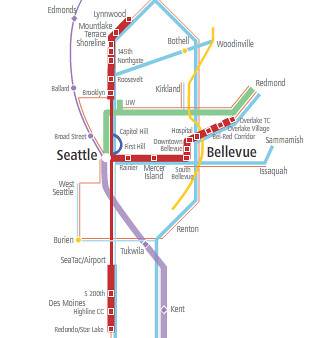
Our second issue in our election-season neighborhood town hall is the phase 2 expansion of Sound Transit.
We’ve talked a lot about transit in the neighborhood and how there’s some room for improvement. Our buses are usually standing-room-only, and so far light rail has passed us by.
But that could change if the Sound Transit expansion is approved by voters next month. One part of the expansion would add a new light rail line from downtown Seattle to Bellevue and Overlake, via the I-90 bridge. That line includes a stop at Rainier on I-90, giving us a rapid transit stop at the far south end of the neighborhood.
Other features of the expansion include:
- A new streetcar line from the International District, up Jackson, and then north on Broadway to First Hill
- Extension of light rail from the UW north to Lynnwood.
- Extension of light rail from SeaTac south to Federal Way
- 100,000 hours of additional express bus service
- Longer Sounder commuter trains with more capacity
- More suburban park-and-ride lots
The expansion will be paid for with an increase in the sales tax, rising from the current 9% up to a new rate of 9.5% for most purchases. Taxes on restaurant and bar purchases would increase to 10%. (a nice bonus: easier tax & tip calculation). Sound Transit estimates that the average family will pay an additional $69 per year in taxes if the measure passes.
Got an opinion? Throw in your thoughts in the comments below. And if you have specific questions about the proposal, leave it as a comment and we’ll try to track down the answer from the people in the know.
For more information:
- Sound Transit information: http://future.soundtransit.org/
- Pro-expansion campaign: http://www.masstransitnow.org/
- Anti-expansion campaign: http://NoToProp1.org/

Even the first part of this system won’t come on line for fifteen years, and the bus expansion is a new bus route in each county, King, Pierce and Snohomish. That’s it folks. Costs too much, does too little, takes too long. Vote No to Prop 1, then take the tax and use it to fix bus service now—service we can use!
chris, with all due respect, if every infrastructure decision were based solely on immediate need, we’d never have built an interstate highway system.
It is long, it is costly, it doesn’t do enough to address all the bus service needs of the area right now, but that doesn’t mean we should make perfect the enemy of the good.
It’s worth pointing out that this isn’t a bungled plan that will service areas not in need–it’s a plan that, once running, will serve real needs and real growth and will make Seattle a modern city with modern transportation options. If you want rail, you’re gonna have to pay for it sometime. Enough talk, enough of Seattle’s unique business of delay and chit chat, and let’s move forward.
Rail based transit with dense building around the stations is the way to go. Unless we can achieve negative population growth.
The transit buses are a stop gap.
Even if they could run enough buses to support the densities envisioned, there would be so many buses that we’d end up building more roads.
Better to consciously build towns around the stations and leave the countryside alone.
The DC area is an abject example. It’s SO obvious how the burbs sprawled exactly where they declined to build another phase of the Metro system and instead invested in new freeways.
This is for your children and our region is 20 years behind.
The first part of the system will come on line NEXT YEAR, with light rail trains running between Westlake and the airport reliably, on time, never getting stuck in traffic. The extension to Capitol Hill and UW will start service in 2016.
We need to begin building the rest of the rail network as soon as we can, so that more people will have more and better options for getting to more places without having to sit in traffic. I read that, when the ST2 rail network is built, something like 85% of jobs in the region will be within reasonable reach of a light rail station.
Another good point for a fixed rail system is that the permanence of the stations attracts density, new housing, and business development because of the proximity to easy transportation. This was how Madison Park was developed, the streetcar was put in to make the houses sell. It is possible to drive development where we want it to go by thinking of where to place the tracks and stations, rather than just reacting to where people are now. It is also a way to help lessen new sprawl by concentrating the easy transportation. Mill Creek and Sammamish Plateau happen because the land is cheap and the easy access by freeway is cheap. If it becomes more expensive to drive and park while becoming more convenient to walk to the train, then we can guide how the city grows. Busses don’t offer the permanence of a fixed route to give people and businesses the confidence of fast and easy service for the future.
If you are interested in learning more and don’t mind a trek over to Broadway, we’ll have a rep from Transportation Choices talking Prop 1 at next week’s Capitol Hill Community Council meeting. Prop 1 part of session will happen around 8p.
http://www.capitolhillcommunitycouncil.org/
CHCC Public Meeting — October
WHEN: Thursday, October 16, from 7pm-9pm
WHERE: Seattle Central Community College, Room #3200
Adding Sounds – HTML Lessons
HTML MUSIC / MEDIA CODE – Sound
http://html-lesson.blogspot.com/2008/06/music-media-code-sou